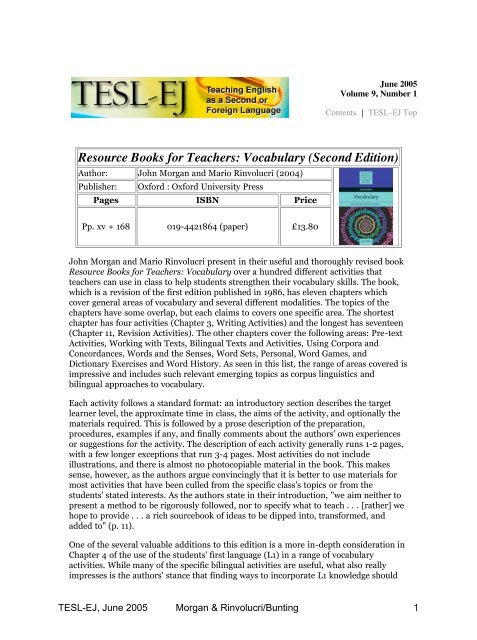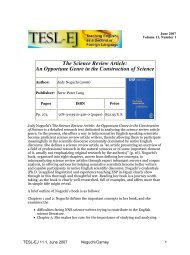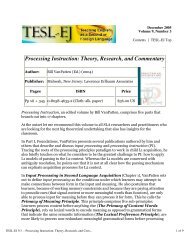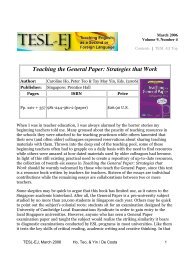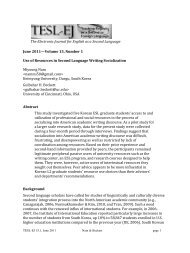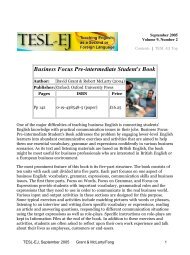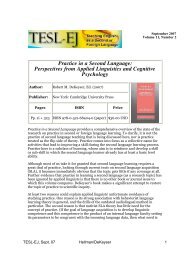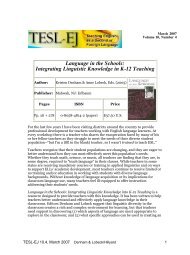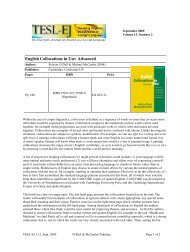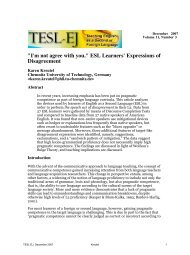PDF version - TESL-EJ
PDF version - TESL-EJ
PDF version - TESL-EJ
Create successful ePaper yourself
Turn your PDF publications into a flip-book with our unique Google optimized e-Paper software.
June 2005<br />
Volume 9, Number 1<br />
Contents | <strong>TESL</strong>-<strong>EJ</strong> Top<br />
Resource Books for Teachers: Vocabulary (Second Edition)<br />
Author: John Morgan and Mario Rinvolucri (2004)<br />
Publisher: Oxford : Oxford University Press<br />
Pages ISBN Price<br />
Pp. xv + 168 019-4421864 (paper) £13.80<br />
John Morgan and Mario Rinvolucri present in their useful and thoroughly revised book<br />
Resource Books for Teachers: Vocabulary over a hundred different activities that<br />
teachers can use in class to help students strengthen their vocabulary skills. The book,<br />
which is a revision of the first edition published in 1986, has eleven chapters which<br />
cover general areas of vocabulary and several different modalities. The topics of the<br />
chapters have some overlap, but each claims to covers one specific area. The shortest<br />
chapter has four activities (Chapter 3, Writing Activities) and the longest has seventeen<br />
(Chapter 11, Revision Activities). The other chapters cover the following areas: Pre-text<br />
Activities, Working with Texts, Bilingual Texts and Activities, Using Corpora and<br />
Concordances, Words and the Senses, Word Sets, Personal, Word Games, and<br />
Dictionary Exercises and Word History. As seen in this list, the range of areas covered is<br />
impressive and includes such relevant emerging topics as corpus linguistics and<br />
bilingual approaches to vocabulary.<br />
Each activity follows a standard format: an introductory section describes the target<br />
learner level, the approximate time in class, the aims of the activity, and optionally the<br />
materials required. This is followed by a prose description of the preparation,<br />
procedures, examples if any, and finally comments about the authors' own experiences<br />
or suggestions for the activity. The description of each activity generally runs 1-2 pages,<br />
with a few longer exceptions that run 3-4 pages. Most activities do not include<br />
illustrations, and there is almost no photocopiable material in the book. This makes<br />
sense, however, as the authors argue convincingly that it is better to use materials for<br />
most activities that have been culled from the specific class's topics or from the<br />
students' stated interests. As the authors state in their introduction, "we aim neither to<br />
present a method to be rigorously followed, nor to specify what to teach . . . [rather] we<br />
hope to provide . . . a rich sourcebook of ideas to be dipped into, transformed, and<br />
added to" (p. 11).<br />
One of the several valuable additions to this edition is a more in-depth consideration in<br />
Chapter 4 of the use of the students' first language (L1) in a range of vocabulary<br />
activities. While many of the specific bilingual activities are useful, what also really<br />
impresses is the authors' stance that finding ways to incorporate L1 knowledge should<br />
<strong>TESL</strong>-<strong>EJ</strong>, June 2005 Morgan & Rinvolucri/Bunting 1
e a priority in finding innovative activities for vocabulary development.<br />
Another of the innovative new components of this book is its inclusion in Chapter 5 of<br />
activities based on advances in corpus linguistics and its effects on vocabulary study<br />
(see also Sinclair, 1991; Lewis, 2000). The authors cite both sources from L2 vocabulary<br />
(McCarthy, 1999) and lexicography (Rundell, 20002) to support this inclusion, and<br />
they include both those activities in which teachers access corpus-based tools to<br />
prepare materials as well as those activities in which students use these tools directly.<br />
What is particularly heartening about the authors' approach to this potentially<br />
confusing topic for teachers is how the authors make each step understandable,<br />
providing for this chapter many clear illustrations and websites for further study. In the<br />
reference material at the end of the book, they also include a range of websites (though<br />
hardly a complete list) where teachers can go to learn about and use such corpus tools<br />
as concordancing programs and word lists.<br />
While this book offers many wonderful tools for teachers, one component that adds<br />
little to its overall usefulness is its use of the "level" label for each activity. Some of the<br />
levels used include "beginner to advanced," "post-beginner to advanced," "elementary to<br />
advanced," "intermediate to advanced," "lower-intermediate to advanced," "upperintermediate<br />
to advanced," "elementary to intermediate," and "all". In the first place,<br />
these level descriptors are never defined, which makes the distinction murky at best.<br />
Further, it is difficult to see, for example, how "all" and "beginner to advanced" differ.<br />
Nor do the authors in most cases include instructions for how to modify activities to fit<br />
the wide range of levels.<br />
In addressing which activities are suitable for different learner levels, what would have<br />
been more useful would have been some way to describe what changes need to be made<br />
in order to convert a task that the authors envisioned as a 'beginner' task into a truly<br />
'advanced' task. The 'level' descriptors are not useful: either the experienced teacher<br />
knows enough about preparing materials that the prose description makes it clear what<br />
level it might serve, or the novice teacher would not know enough about how to modify<br />
the activity as described to fit a different level. In other words, when most of the<br />
activities are labeled for all levels, the category becomes essentially meaningless and<br />
therefore superfluous.<br />
It also would have been wonderful to have seen more activities that emphasized<br />
vocabulary connected to writing activities (that chapter was the shortest in the book,<br />
almost perfunctory, with only four short activities), though many activities in the other<br />
chapters touch on the vocabulary/writing connection and could easily be modified to<br />
include a writing component. Another useful element that is missing is a determination<br />
regarding the appropriate age group for each activity. In reviewing the activities, it<br />
seems that there are many that are suited primarily for children but might not be<br />
suitable for adults. Including such a distinction might be a useful filtering tool for<br />
teachers using the book.<br />
This book provides a large number of inventive and varied vocabulary activities, easily<br />
referenced through effective chapter demarcations and useful, practical activity<br />
headings. For a busy teacher looking for different ways to introduce and then effectively<br />
recycle words (Folse, 1996; Nation, 1990; Schmitt, 2000), Morgan and Rinvolucri have<br />
done a wonderful job updating their earlier work, adding important new ideas while still<br />
keeping the text readable and accessible to teachers at all levels.<br />
<strong>TESL</strong>-<strong>EJ</strong>, June 2005 Morgan & Rinvolucri/Bunting 2
References<br />
Folse, K. (2004). Vocabulary myths: Applying second language research to classroom<br />
teaching. Ann Arbor, MI: University of Michigan Press.<br />
Lewis, M. (2000). Materials and resources for teaching collocation. In M. Lewis (Ed.),<br />
Teaching collocation: Further development in the lexical approach (pp. 186-204).<br />
Hove, UK: Language Teaching Publications.<br />
McCarthy, M. (1998). Spoken language and applied linguistics. Cambridge: Cambridge<br />
University Press.<br />
Nation, I. S. P. (1990). Teaching and learning vocabulary. Boston: Heinle & Heinle<br />
Rundell, M. (2002). If only they'd asked a linguist. Humanising Language Teaching, 4<br />
(4) Accessed on April 24, 2005 http://www.hltmag.co.uk/jul02/idea.htm<br />
Schmitt, N. (2000). Vocabulary in language teaching. Cambridge: Cambridge<br />
University Press.<br />
Sinclair, J. (1991). Corpus, concordance, collocation. Oxford: Oxford University Press.<br />
John Bunting<br />
Georgia State University<br />
<br />
© Copyright rests with authors. Please cite <strong>TESL</strong>-<strong>EJ</strong> appropriately.<br />
Editor's Note: The HTML <strong>version</strong> contains no page numbers. Please use the <strong>PDF</strong><br />
<strong>version</strong> of this article for citations.<br />
<strong>TESL</strong>-<strong>EJ</strong>, June 2005 Morgan & Rinvolucri/Bunting 3


